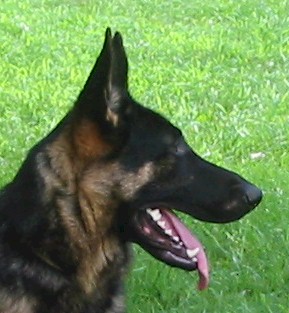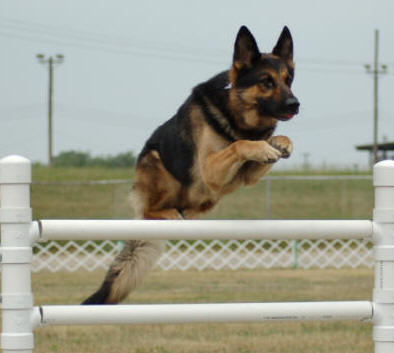 |
Agility Training A Veterinarian's Perspective |
|||||||||||||||||
|
Take a look at the page below to see some orphans that need a loving home!
|
||||||||||||||||||
|
Last updated 8/01/07
The obstacles include;
Though the sport is relatively new, the skills involved have long been used in training, conditioning, and confidence-building for dogs. Obstacles used for agility aid in training police dogs, military dogs and search and rescue dogs. Obedience trials include basic jumps because the ability and willingness to negotiate obstacles in the way the handler specifies is part of the definition of a trained dog. Here at Sequoyah Shepherds, we have just begun our very first dog in agility classes. We are hoping to trial her in both AKC agility as well as Service Dogs of America (SDA). We have found that the dogs really enjoy the challenges that agility presents for them and seem to gain an immense amount of self-confidence when they are able to "show off" their ability. We have also decided to start incorporating puppy-level obstacles in our breeding program in order to mentally and physically condition confident puppies. This will help our puppy buyers later in life because this early conditioning seems to really help young pups face new situations. They gain confidence when required to walk on unusual surfaces, or navigate new obstacles that they have never seen before (i.e. tunnels). Each time that they successfully "conquer" their insecurities they are lavishly rewarded. Soon they begin to look forward to the next great "adventure".
Getting Ready for Agility Your dog must be prepared to begin his/her agility classes. They must learn to:
Many other basic training skills will help the new agility competitor, but these will get you started. The joints of young dogs are not mature enough for the stress of jumping, so puppyhood and adolescence are perfect times to spend working on basic skills in classes that also acclimate your dog to the atmosphere of dog events. Check online and with clubs and trainers in your area to find opportunities for training with your dog. American Kennel Club agility events are one option. The Service Dogs of America (SDA) is another option. I am sure that there are many more so look around! The rules, the titles, the jump heights and other factors differ from one organization to another. Find the ones in your area with the rules that best fit your dog. Consult your veterinarian about your dog’s age, health, and conditioning for the agility activities you want to pursue. Agility can be a fun activity for you and your dog on a casual level, noncompetitively, with jumps set to easy heights for your dog. But, Agility at the serious competition levels can strain a dog’s body, (See GSD Health -- Orthopedic Issues) and it’s important to make sure your dog is suited for it. Your dog’s welfare will always be your top priority. Make sure your agility class instructor knows what your goals are.
The Best Parts Agility encourages people to train with their dogs. The basic skills needed to control your dog before you start agility training are the same skills for handling your dog in public places. This means you and your dog will be able to go more places together, which creates a wonderful bond between you. Dogs feel that the leader of the expedition—an expedition being any trip beyond the house and fenced yard—is awesome! Taking your dog places raises your dog’s opinion of you; that is, as long as you use the good training and handling skills the two of you learn together in class. If you behave in such a way that your dog feels safe to be out with you, your relationship is sure to become deeper and more rewarding. The dog training developed by agility competitors is truly astonishing. Because they combine accuracy with speed, creative agility enthusiasts constantly develop innovative new ways to teach dogs to take direction. As has happened with dog training of all kinds, ideas developed in the sport of agility are advancing work for other purposes, too. Even therapy dogs and assistance dogs make use of directional signals and verbal cues like those used in agility to maneuver in everyday settings. We continue to learn more things dogs are capable of, and how to communicate these tasks to our dogs. In the process, we increase the ways in which dogs enhance human lives. Make no mistake about it, dogs love being deeply involved in our lives, helping us, and knowing they are important to us. Agility is a fun form of exercise for people and dogs. It gives you a reason to get out and train with your dog, on your own as well as in enjoyable group settings with other dog lovers. In the process, you and your dog become a great team.
|
